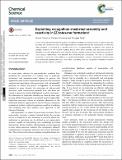Files in this item
Exploiting recognition-mediated assembly and reactivity in [2]rotaxane formation
Item metadata
| dc.contributor.author | Vidonne, Annick | |
| dc.contributor.author | Kosikova, Tamara | |
| dc.contributor.author | Philp, Douglas | |
| dc.date.accessioned | 2016-03-23T15:00:05Z | |
| dc.date.available | 2016-03-23T15:00:05Z | |
| dc.date.issued | 2016-04-01 | |
| dc.identifier | 240255926 | |
| dc.identifier | 2ae3c3b2-f7da-4b7c-8e31-743e9c674906 | |
| dc.identifier | 84962321118 | |
| dc.identifier | 000372614800016 | |
| dc.identifier.citation | Vidonne , A , Kosikova , T & Philp , D 2016 , ' Exploiting recognition-mediated assembly and reactivity in [2]rotaxane formation ' , Chemical Science , vol. 7 , no. 4 , pp. 2592-2603 . https://doi.org/10.1039/C5SC04805B | en |
| dc.identifier.issn | 2041-6520 | |
| dc.identifier.other | ORCID: /0000-0002-9198-4302/work/56639234 | |
| dc.identifier.uri | https://hdl.handle.net/10023/8472 | |
| dc.description | The authors thank EaStCHEM (Graduate Studentship to AV), EPSRC (Graduate Studentship to TK, Grant EP/K503162/1) and the University of St Andrews for financial support. | en |
| dc.description.abstract | A small molecular reaction network exploits recognition-mediated reactive processes in order to drive the assembly and formation of both a self-replicating linear template (thread) and a [2]rotaxane, in which the linear template is encircled by a diamide macrocycle. Complementary recognition sites, placed at strategic positions on the reactive building blocks, drive these assembly and replication processes. Template-instructed experiments show that the thread is capable of efficient self-replication and that no cross-catalytic relationships exist between thread and the [2]rotaxane. The rate of [2]rotaxane formation is insensitive to the addition of preformed template, however, [2]rotaxane formation does show enhanced diastereoselectivity, most likely originating from its recognition- mediated formation through a binary reactive complex. | |
| dc.format.extent | 2151377 | |
| dc.language.iso | eng | |
| dc.relation.ispartof | Chemical Science | en |
| dc.subject | QD Chemistry | en |
| dc.subject | DAS | en |
| dc.subject.lcc | QD | en |
| dc.title | Exploiting recognition-mediated assembly and reactivity in [2]rotaxane formation | en |
| dc.type | Journal article | en |
| dc.contributor.institution | University of St Andrews. School of Chemistry | en |
| dc.contributor.institution | University of St Andrews. EaSTCHEM | en |
| dc.contributor.institution | University of St Andrews. Biomedical Sciences Research Complex | en |
| dc.identifier.doi | https://doi.org/10.1039/C5SC04805B | |
| dc.description.status | Peer reviewed | en |
| dc.identifier.url | http://www.rsc.org/suppdata/c5/sc/c5sc04805b/c5sc04805b1.pdf | en |
This item appears in the following Collection(s)
Items in the St Andrews Research Repository are protected by copyright, with all rights reserved, unless otherwise indicated.

